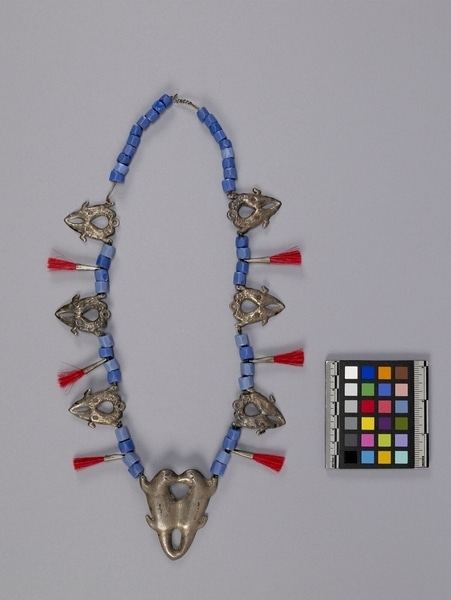Necklace Item Number: 1590/97 from the MOA: University of British Columbia

Description
Necklace consisting of 43 blue glass beads strung on wire. Six small and one large "kissing" otters divided by sets of four beads with conical silver ornament with red bristles. The back portion of the necklace has nineteen beads. Each otter has the maker's stamp in a cartouche.
History Of Use
Silver ornaments represent an important part of early exchange between Europeans, including fur traders, and first nations people, especially in Eastern and Central Canada and the USA. Initially, the main sources of silver were British, French, and Spanish coins. Most ornaments were produced by silversmiths of European origin in North America and Europe, and were actively traded only from 1760 to 1821. By the mid-18th century silver objects were produced in New England, Quebec and Montreal. Silver was used by first nations people as a sign of rank. Silver ornaments in these styles continue to be produced by native silversmiths in Central Canada and the USA. Animal imagery is a significant part of woodland first nations tradition, but no documented instance has been found of the use of animal effigies in trade. The place of effigies in woodlands culture is not known.
Cultural Context
trade; personal ornamentation; political alliance
Item History
- Made by Louis Jackson ? (Maker) in Canada ? or USA ? between 1760 and 1821
- Owned by Mr. Fitzgerald
- Owned by Kathleen E. Reif before September 9, 1993
- Received from Kathleen E. Reif (Donor) on September 9, 1993
What
Who
- Culture
- Eastern Woodlands
- Creator
- Louis Jackson ? (Maker)
- Previous Owner
- Mr. Fitzgerald and Kathleen E. Reif
- Received from
- Kathleen E. Reif (Donor)
Where
- Holding Institution
- MOA: University of British Columbia
- Made in
- Canada ? or USA ?
When
- Creation Date
- between 1760 and 1821
- Ownership Date
- before September 9, 1993
- Acquisition Date
- on September 9, 1993
Other
- Item Classes
- metalwork; beadwork
- Condition
- good
- Current Location
- Case 45
- Accession Number
- 1590/0097